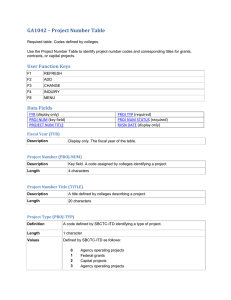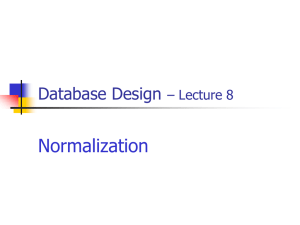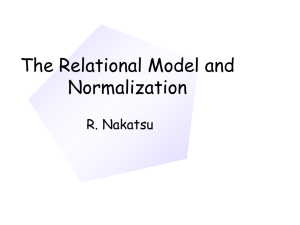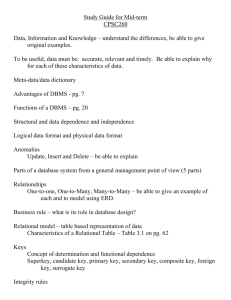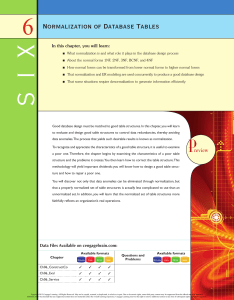College of computer technology Information network department Introduction to database lecture 10
advertisement
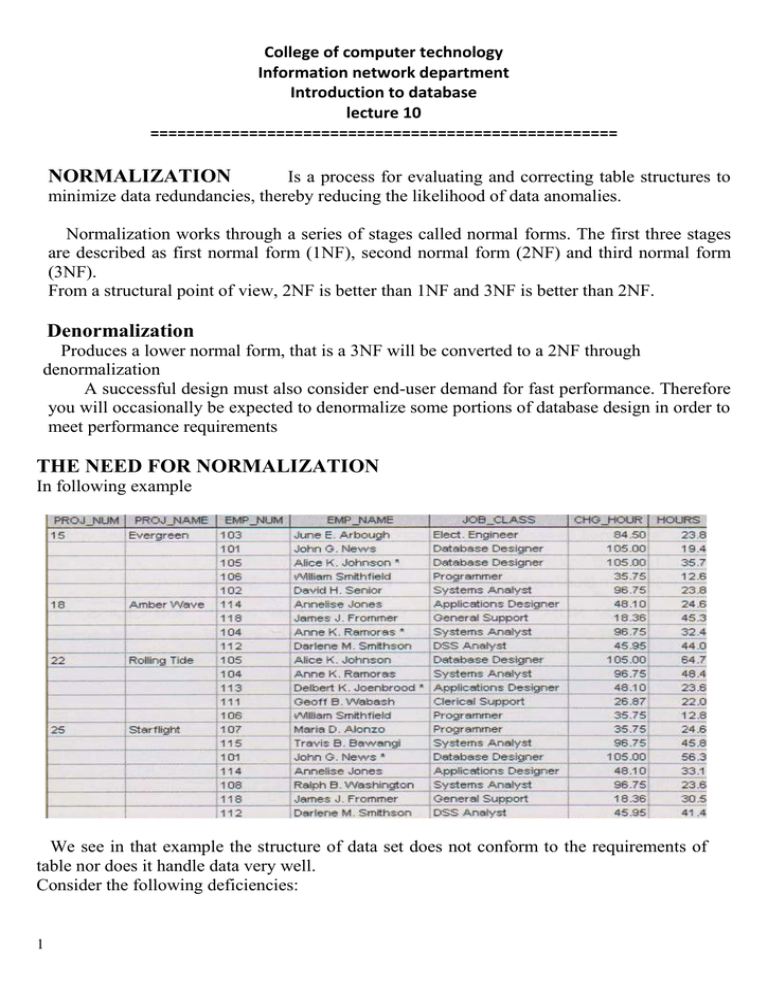
College of computer technology Information network department Introduction to database lecture 10 ==================================================== NORMALIZATION Is a process for evaluating and correcting table structures to minimize data redundancies, thereby reducing the likelihood of data anomalies. Normalization works through a series of stages called normal forms. The first three stages are described as first normal form (1NF), second normal form (2NF) and third normal form (3NF). From a structural point of view, 2NF is better than 1NF and 3NF is better than 2NF. Denormalization Produces a lower normal form, that is a 3NF will be converted to a 2NF through denormalization A successful design must also consider end-user demand for fast performance. Therefore you will occasionally be expected to denormalize some portions of database design in order to meet performance requirements THE NEED FOR NORMALIZATION In following example We see in that example the structure of data set does not conform to the requirements of table nor does it handle data very well. Consider the following deficiencies: 1 College of computer technology Information network department Introduction to database lecture 10 ==================================================== 1. The project number (PROJ_NUM) is apparently intended to be primary key or at least a part of a PK, but it contains nulls. 2. The table entries invite data inconsistencies. For example the JOB_CLASS value "Elect. Engineer" might be entered as "Elect. Eng." 3. The table displays data redundancies. Those data redundancies yield the following anomalies: a. Update anomalies. Modifying the JOB_CLASS for employee number 105 requires (potentially)many alterations, one for each EMP_NUM=105. b. Insertion anomalies. Just to complete a row definition, a new employee must be assigned to a project. If the employee is not assigned, a phantom project must be created to complete the employee data entry C. Deletion anomalies suppose that only one employee is associated with a given project. if that employee leaves the company and the employee data are deleted , the project information will also be deleted .to prevent the loss of the project information ,a fictitious employee must be created just to save the project information. THE NORMALIZATION PROCESS We will learn how to use normalization to produce a set of normalized tables to store the data that will be used to generate the required information. The objective of normalization is to ensure that each table conforms to the concept of well-formed relations, that is, tables that have the following characteristics: _ Each table represents a single subject. For example, a course Table will contain only data that directly pertains to courses. Similarly, a student table will contain only student data. _ No data item will be unnecessarily stored in more than one table (in short, tables have minimum controlled redundancy).The reason for this requirement is to ensure that the data are update in only one place. _ All nonprime attributes in a table are dependent on the primary key. The reason for this requirement is to ensure that the data are uniquely identifiable by a primary key value. _ Each table is void of insertion, update or deletion anomalies. This is to ensure the integrity and consistency of the data. Conversion to FIRST NORMAL FORM (1NF) STEP 1: Eliminate the Repeating Groups Start by presenting the data in tabular format, where each sale has a single value and there are no repeating groups .A repeating group derives its name from the fact that a group of multiple entries of the same type can exist for any single key attributes occurrence .To eliminate the repeating groups ,eliminate the nulls by making sure that each repeating group attribute contains an appropriate data value. 2 College of computer technology Information network department Introduction to database lecture 10 ==================================================== Step 2: Identify the primary key Even a causal observer will not that PROJ-NUM is not an adequate primary key because the project number does not uniquely identify all of the remaining entity (row) attributes. To maintain a proper primary key that will uniquely identify any attribute value, the new key must be compost of a combination of a PROJ_NNUM and EMP_NUM Step 3:Identify All Dependencies The identification of the PK in Step 2 means that you have already identified the following dependency: PROJ_NUM,EMP_NUMPROJ_NAME,EMP_NAME,JOB_CLASS,CHG_HOUR,HOURS PROJ_NUM PROJ_NAME EMP_NUM EMP-NAME, JOB-CLASS,CHG-HOUR JOB_CLASSCHG_HOUR 3 College of computer technology Information network department Introduction to database lecture 10 ==================================================== The dependencies you have just examined can also be depicted with the help of the diagram known as dependency diagram Partial dependency a dependency based only a part of a composite primary key Transitive dependency is a dependency of one nonprime attribute on another nonprime attribute The term first normal form (1NF) describes the tabular format in which: All of the key attributes are defined. There are no repeating groups in the table. in other words, each row/column intersection contains one and only one value, not a set of values. All attributes are dependent on the primary key. The problem with the 1NF table structure is that it contains partial dependencies. While partial dependencies are sometimes used for performance reasons, they should be used with caution Conversion to Second Normal Form(2NF) Converting to 2NF is done only when the 1NF has a composite primary key. if the 1NF has a single attribute primary key, then the table is automatically in 2NF.The 1NF-to-2NF conversion is simple starting with Step 1:Write Each Key Component on a Separate Line Write each key component on a separate line; then write the original (composite) 4 College of computer technology Information network department Introduction to database lecture 10 ==================================================== key on the last line. PRO_NUM EMP_NUM PROJ_NUM EMP_NUM Each component will become the key in a new table. In other words, the original table is now divided in to three tables (PROJECT ,EMPLOYEE, and ASSIGNMENT). Step 2: Assign Corresponding Dependent Attributes Use dependency diagram to determine those attributes that are dependent on other attributes PROJECT(PROJ_NUM,PROJ_NAME) EMPLOYEE(EMP_NUM,EMP_NAME,JOB_CLASS,CHG_HOUR) ASSIGNMENT(PROJ_NUM,EMP_NUM, ASSIGN_HOURS) 5 College of computer technology Information network department Introduction to database lecture 10 ==================================================== A table is in second normal form (2NF)when it is in 1NF And it includes no partial dependencies ;that is, no attribute is dependent on only portion of the primary key. Note that is still possible for a table in 2NF to exhibit transitive dependency; that is, one or more attributes may be functionally dependent on nonkey attributes. Conversion to Third Normal Step 1: Identify the Dependent Attributes For every transitive dependency, write its determinant as PK for a new table. JOB_CLASS Step 2: Identify the Dependent Attributes Identify the attributes that are dependent on each determinant identified in Step 1 and identify the dependency. JOB_CLASS CHG_HOUR Name the table to reflect its contents and function. In this case, JOB seems appropriate. Step 3: Remove the Dependent Attributes from Transitive Dependencies Eliminate all dependent attributes in the transitive relationship(s) from each of tables that have such a transitive relationship. EMP_NUM EMP_NAME,JOB_CLASS Note that the JOB_CLASS remains in the EMPLOYEE table to save as FK. After the 3NF conversion has been completed, your database contains four tables: 6 the College of computer technology Information network department Introduction to database lecture 10 ==================================================== A table is in 3NF when It is in 2NF It contains no transitive dependencies 7
